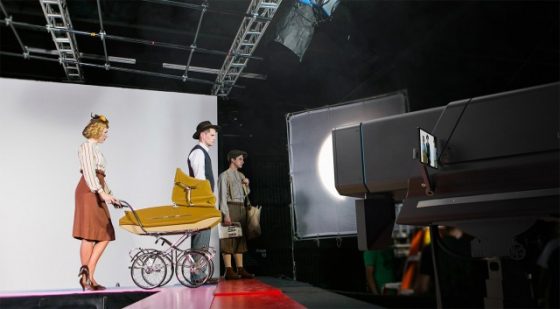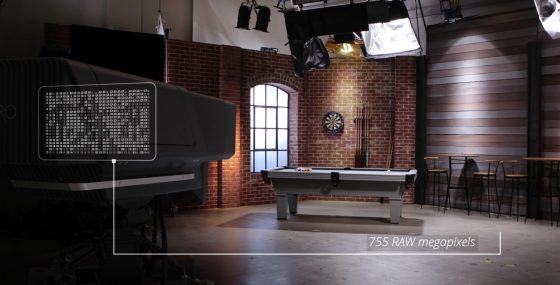The new Cinema Camera takes light field photography into video.
By Kathleen Maher
One of the most talked about events at NAB 2016 was the debut of the Lytro Cinema camera. A long, long line of eager photography fans, broadcast professionals, and press more than filled the big meeting room designed to hold 500 people. Many more than that squeezed in.
The idea of Lytro has been thrilling and disappointing people since the company’s founding in 2006. Lytro is built around the notion of a plenoptic camera—a massively multi-lens camera that can record depth information as well as light and color.

The result is called Light Field technology, and at NAB we saw the first swarms of an ecosystem forming. The Foundry helped Lytro process the camera’s output and create effects. Technicolor aided in the color grading. Google has helped Lytro develop a cloud management system for the huge amounts of data gathered by the camera. At the NAB event, presenters said just the UI is downloaded for work with the Lytro content in the cloud. Therefore, editors can work on Lytro using lightweight clients if they want to include tablets, mobiles, or low-cost laptops.
John Karafin, head of light field video for Lytro, described the camera’s operation to the audience. He said the Lytro Cinema camera has millions of lenses, but the camera will allow people to work like they always have. Cinematographers will make decisions about frame rate, focus, exposure, etc., but they won’t be limited by those decisions because the Lytro captures so much information from the scene that focus can be adjusted, with depth-of-field effects created after the fact. Motion blur and relighting are not so much special effects as they are ghosts in the machine’s visual information that’s present in the capture from the start.
The demo made some industry professionals nervous because Lytro promises to undo the work of a lifetime. Taken to its logical extreme, light field photography makes all the complex thinking around capturing an image unnecessary because there’s so much coverage. As Lytro puts it, this new technology enables the virtualization of the live action camera. Jason Rosenthal, Lytro CEO, said, “We are in the early innings of a generational shift from a legacy 2D video world to a 3D volumetric light field world.”

So far, however, the Lytro isn’t going to put people out of jobs. A good cinematographer is still going to consider what the camera can do and what she wants it to do. A good cinematographer will get a better shot, with a useful range of adjustment, than will a bad cinematographer.
The Foundry’s Brad Peebler talked to John Karafin after the presentation, and he talked about the ways in which the Lytro can enable shots that would be impossible to do with one camera in other systems.
The Lytro camera enables every frame of a live action scene to become a 3D model. Pixels have color, directional, and depth properties that enable photography to live in the same space as VFX. If you think about the ways in which 3D modeling is being used to create stereo 3D movies, you can see that the Lytro will be a powerful tool for 3D content creation. In addition, the 3D data present in the Lytro content enables light field tracking and Lytro depth screen, which translates to accurate green screens for every object and space in the scene without any actual green screens.
Lotta’ stuff
The Lytro camera has a 755-megapixel sensor, which Karafin told the NAB audience is the largest video sensor ever made. “If there’s a bigger one,” he said, “I want you to tell me about it.” The sensor can capture data at up to 300 frames per second. It has up to 16 stops of dynamic range and a wide color gamut. The camera provides integrated high-resolution active scanning, which promises a lot more that this technology might be able to do.
Lytro says their Cinema camera produces a Light Field Master, which enables creators to render content in multiple formats including iMax, RealD, and traditional cinema. It can be broadcast at variable frame rates and shutter angles.
The Lytro Cinema camera will be delivered as a system including a server array for storage and processing. In other words, the company plans to support cloud-based workflows using Google, but also on location.

At NAB, the company premiered Life, the first short shot with the camera. They worked with the Virtual Reality Company (VRC). The film was directed by Robert Stromberg, (who won art direction Academy Awards for Alice in Wonderland and Avatar) and is the chief creative officer for VRC. It was shot by David Stump, chief imaging scientist at VRC.
The filmmakers shot Life using the Light and an Arri Alexa. They used the two cameras to demonstrate that the Lytro’s output blends with that of the Arri. The visual quality didn’t blow anyone away, but it was certainly competent.
Stromberg told the audience that working with the Lytro had its challenges—“as you can see, it’s not the easiest thing to move around,” he said. But he also said, “These guys are really onto something really special. I think this camera, when it gets to be a functional camera, will change the way we create and think about film.” As an aside, almost everyone I asked about this technology said something similar. “If they can do what they say they can do …” There’s some worry about Lytro being able to deliver (before they run out of time and money), but there is plenty of hope that they succeed beyond expectations.
The Lytro Cinema camera will be available to customers on a subscription basis to exclusive partners in Q3 2016.
What do we think?
Let’s go back, briefly, to the ways in which the Lytro has disappointed excited photography fans. Lytro technology was first developed as a consumer camera. It was developed as a Kickstarter project, and the finished product, the Lytro Illum, was small and generally disappointing. Customers said they didn’t see anything special in the photos captured. There apparently wasn’t much range for re-focusing, and the camera’s tiny screen made the task difficult anyway. The successor, the Lytro Illum 40, was an improvement, and the critics were kind but consumers weren’t having it. They found it too complicated. The camera offered options for capture, hardly fostering spontaneity, and people complained that there wasn’t much range for refocusing.
The camera isn’t magic. The possibilities are limited, but I think that with the Lytro Cinema camera and also the Lytro Immerge camera, which is being developed for VR, the company is finally working with potential customers who understand the challenge of what the company is trying to do and who are eager for the capabilities the camera can provide. These industry customers know what to do with this camera. In contrast, the early reviews of the Lytro consumer cameras often included the apologetic qualification that the people just weren’t sure what to do with the camera—and at that time their options were limited. Customers had to rely primarily on the in camera options for editing or the supplied Desktop application
Maybe we want to remember what the great German filmmaker Ernest Lubitsch had to say: “There are a thousand ways to point a camera, but really only one.”





